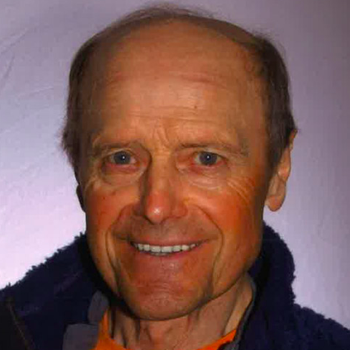Sidebar Include
To make changes, the file below must be edited. Email Carl with any questions ([email protected]).
Hermann Gollner
 Hall of Fame Class of 2017
Hall of Fame Class of 2017
Bio Content
After his promising competitive career was cut short, Hermann Gollner pioneered freestyle aerials, became an iconic coach and invented a ground-breaking race gate.
Among skiing’s cognoscenti, Herman Gollner is a revered, almost mythical figure. But despite pioneering freestyle aerials, designing the screw in race gate still in use today and coaching some 20 racers to the ranks of U.S. Ski Team, the Austrian native’s remarkable multi-tasking has stayed mostly under the radar with the general skiing public.
Combining a gymnastics background with painstaking preparation, Gollner performed the world’s first double backward somersault and then the first triple forward flip in the mid-1960s. Gollner next released the remarkable Moebius Flip, a single flip with a full twist that happened so quickly it was confusing to the naked eye. Along with partner, Tom Leroy, Gollner pushed the needle on aerial acrobatics while appearing in groundbreaking films such as The Moebius Flip and Ski the Outer Limits. Performing on 210-centimeter GS skis and forced to repeatedly absorb the shock of mostly flat landing zones, the two set the table for the creation of the free style aerials discipline that has been an Olympics staple since 1992.
While teaching and coaching at Killington in the late 1960s, Gollner was a consistent top finisher on the professional ski racing circuit. Seamlessly shifting gears, in 1971 he won the first international freestyle competition at Waterville Valley, N.H. and the key to a shiny, new Corvette Stingray. But rather than chase his own aspirations, Gollner accepted the position as head coach of the newly founded Stratton Mountain School in Vermont, embracing a long and legendary career as a race coach. He became famous and grudgingly beloved by his students for a quiet intensity and hard-core approach to dryland training, which might involve hauling a backpack full of rocks on a long-distance run. But his main goal was always to bring out the best in others and the racers he touched remain fiercely loyal to him today.
He coached at Stratton from 1971 to 1985, mentoring some 20 skiers to reach the U.S. Ski Team roster. While he spent a two year stint leading the Women’s U.S. Ski Team from 1978 through the 1980 Olympics, his most significant contribution – and passion – was in working with athletes in their critical formative years.
The hinged plastic slalom gate changed ski racing when it was introduced in the early 1980s, allowing competitors to ski through rather than around the old bamboo poles. But the gates kept coming out of the snow, forcing coaches and gatekeepers into a non-stop drill to replace them. As a skilled climber familiar with the ice screw used in glacier climbing, Gollner invented a threaded pole base that would screw firmly into place in the snow – and also flex over a wider radius. It was adopted by the FIS in 1987 and has been a fixture ever since, though the invention was a “financial disaster” for Gollner due to exorbitant costs of the fabrication and patenting process.
Born on September 5, 1943, the son of a policeman and stay-at-home mother, Gollner was raised in the Austrian resort town of Zell Am See. His loves were soccer, gymnastics, mountain climbing and skiing and he was extremely proficient in all. Gollner won the Austrian Junior Championship GS at age 16 but then broke both of his legs in a horrific downhill training crash the next season. After bouncing back to win the European Junior Championship combined in 1961, he crashed his new car, an Audi that he’d bought on credit, while driving back from a climbing trip in the Dolomites. He quickly realized that he’d have to work for ten years straight just to pay for the debt and that led him to immigrate to the U.S. in the fall of 1964. No less an authority than Jean-Claude Killy would later wonder what Gollner might have accomplished if his Austrian team career hadn’t been cut short.
After leaving Stratton in the mid-1980s, Gollner served as a head coach at premier programs in Squaw Valley, Aspen and Sugar Bowl and also worked as a private coach for eight years. Now retired and living near Lake Tahoe, he remains a model of fitness at age 74. He’s currently rehabbing from two knee replacements and recovering his world-class climbing form. After conquering the legendary 5.13a Pump-o-Rama wall in Rifle Mountain Park three years ago, a feat that’s been accomplished by perhaps two or three people in the world at his age, his next goal is to climb even higher.
Career Highlights:
1959: Winner, Austrian Junior Alpine Championships GS
1961: Winner, European Junior Alpine Championships combined
1964: Immigrated to the U.S. and settled in Killington, VT
1965: Performed first double backward somersault
1967: Performed first forward triple somersault
1968: Created the Moebius Flip
1971: Winner of first premier international freestyle competition at Waterville Valley, N.H.
1971-1985: Served as head coach at Stratton Mountain School with two year break to lead women’s U.S. Ski Team
1987: FIS adopts Gollner’s screw-in slalom pole
1986-2013: Held head coaching positions at Aspen, Squaw Valley and Sugar Bowl; also served as a private coach
Video Include
To make changes, the file below must be edited. Email Carl with any questions ([email protected]).
Hall of Fame Tribute Video
Corrections?
If you notice any errors or inconsistencies in Hermann Gollner's bio, click here to let us know.
Please fill out the form to report any errors present on this page. We will correct them as soon as we can. Thanks for taking the time to let us know of any mistakes!

